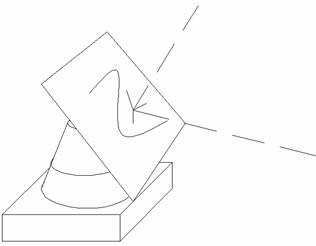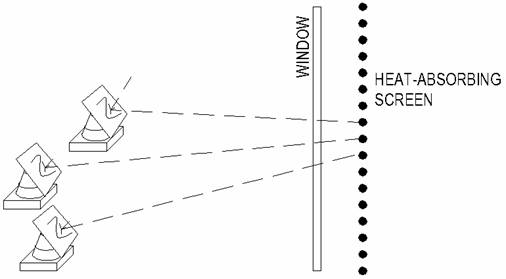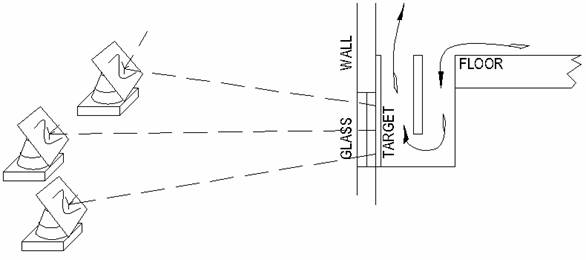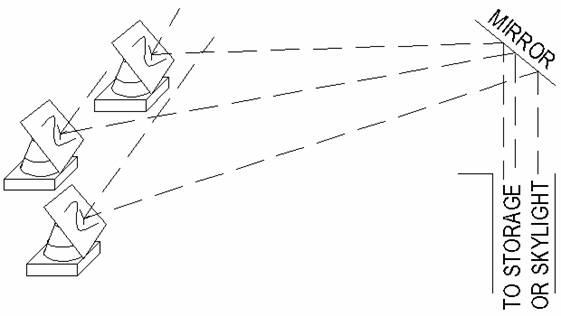 If a small-scale – say,
under ten square foot – module could be produced for a low enough
cost, exciting possibilities would open up. This modular and
versatile control of sunlight itself could instantly revolutionize
the solar energy industry:
If a small-scale – say,
under ten square foot – module could be produced for a low enough
cost, exciting possibilities would open up. This modular and
versatile control of sunlight itself could instantly revolutionize
the solar energy industry:Heliostat Module
A basic heliostat is a mirror mounted so that it can be tilted to reflect sunlight. Properly motorized and programmed, a heliostat can keep a reflected image of sunlight on a specified target throughout the day. There have been experimental power plants in Southern California and New Mexico where dozens of heliostats were programmed to keep their images on boilers, which produced steam for generating electricity.
 If a small-scale – say,
under ten square foot – module could be produced for a low enough
cost, exciting possibilities would open up. This modular and
versatile control of sunlight itself could instantly revolutionize
the solar energy industry:
If a small-scale – say,
under ten square foot – module could be produced for a low enough
cost, exciting possibilities would open up. This modular and
versatile control of sunlight itself could instantly revolutionize
the solar energy industry:
1. Modules could be mounted on the ground, roof tops, or even the sides of walls or fences.
2. Power levels could be upgraded on an economical modular basis, as needs and and/or resources increased.
3. Buildings in shadows could receive heat from units on other buildings.
4. Heat is primarily moved by radiation, rather than by ducts or plumbing, saving installation expense and thermal losses.
5. Portable units could be set up and programmed within a few minutes per unit, and provide instant relief in emergency situations.
6. Any partly-sunny remote area could become a comfortable, state-of-the-art place to live.
7 Farmers with orchards who spend thousands in dollars and damage to drape fruit trees with tinsel to frighten birds would be well served. A few of these could be programmed to sweep a target area with intense beams of sunlight in any pattern desired, without even physically touching the trees. The units could then be redeployed during winter to serve other needs
8 A small group of these could be the basis of an electrical generation plant for a locally sustainable village, or even at the household level. When thus applied to the generation of power, and to the synthesis of portable fuels, you have created a basic energy component for a non-polluting, energy-rich civilization.
A Few Other Applications:
Sunlight to our house in Colorado was limited by a building next to us on the south. One bitter morning of single-digit temperatures I got up early and positioned an array of mirror tiles north of the house so that morning sun was blasting into our living room from a north-facing window. It did a little bit to warm the house, but made a beautiful child out of my wife – it was well worth it. Of course it needed adjustment about every 20 minutes, and after a couple of these, even love couldn’t get me out there again.
In its' simplest form, light could be reflected through a north-facing window, where it could be absorbed by a special screen mounted a few inches inside. The screen would attenuate the light to an acceptable level, and convert the rest of the energy into heat.

Another technique would be to have special ducts with built-in targets below the floor level. These would heat a room by means of convection.

An alternative system would use a periscope to direct the energy downward, where it could be either used directly for convection heating, or stored for evening use.
In a lighting application, with diffusers mounted below roof-top light tubes, this could save some industrial buildings thousands per month in lighting alone.
